2010 JEEP LIBERTY sensor
[x] Cancel search: sensorPage 59 of 522
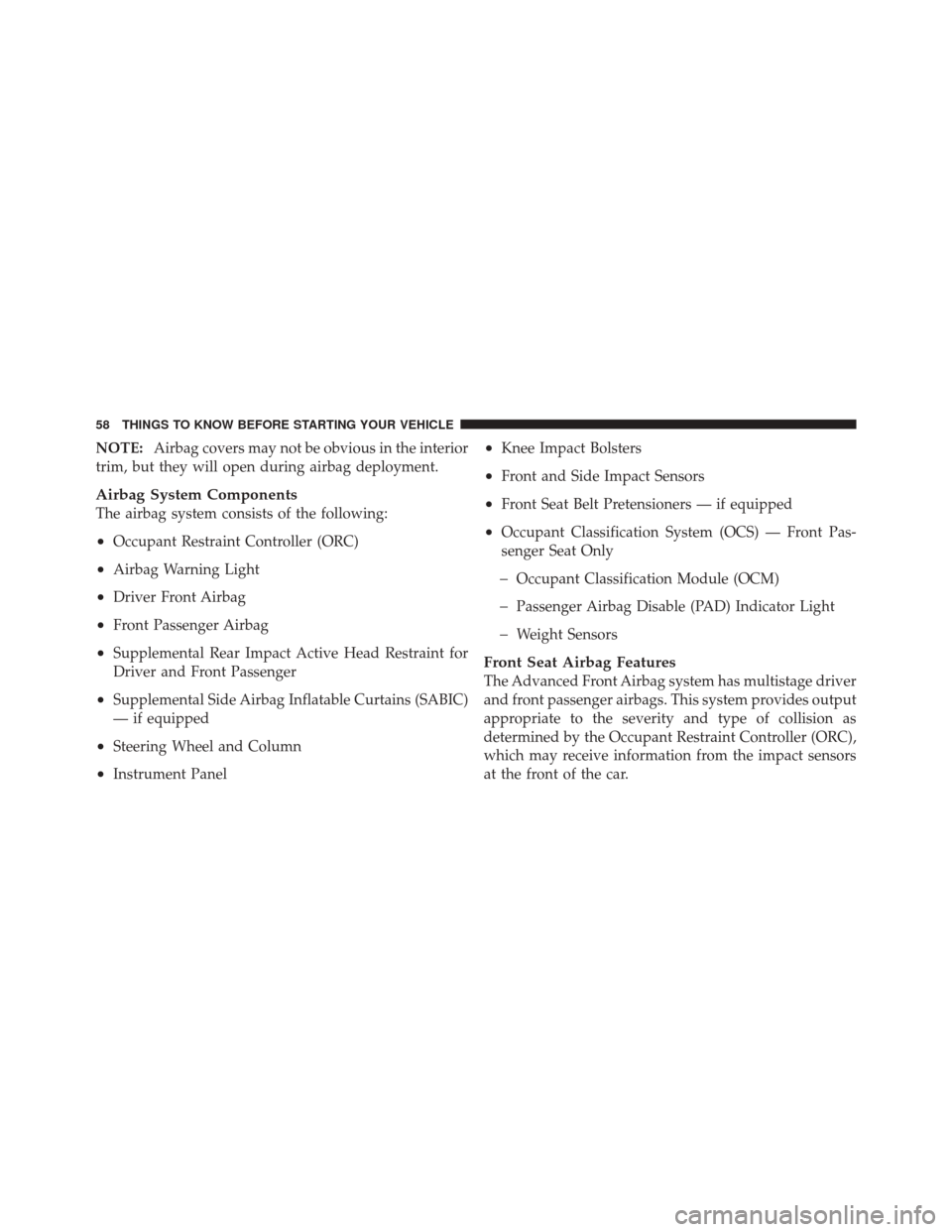
NOTE:Airbag covers may not be obvious in the interior
trim, but they will open during airbag deployment.
Airbag System Components
The airbag system consists of the following:
•Occupant Restraint Controller (ORC)
•Airbag Warning Light
•Driver Front Airbag
•Front Passenger Airbag
•Supplemental Rear Impact Active Head Restraint for
Driver and Front Passenger
•Supplemental Side Airbag Inflatable Curtains (SABIC)
— if equipped
•Steering Wheel and Column
•Instrument Panel
•Knee Impact Bolsters
•Front and Side Impact Sensors
•Front Seat Belt Pretensioners — if equipped
•Occupant Classification System (OCS) — Front Pas-
senger Seat Only
�Occupant Classification Module (OCM)
�Passenger Airbag Disable (PAD) Indicator Light
�Weight Sensors
Front Seat Airbag Features
The Advanced Front Airbag system has multistage driver
and front passenger airbags. This system provides output
appropriate to the severity and type of collision as
determined by the Occupant Restraint Controller (ORC),
which may receive information from the impact sensors
at the front of the car.
58 THINGS TO KNOW BEFORE STARTING YOUR VEHICLE
Page 61 of 522
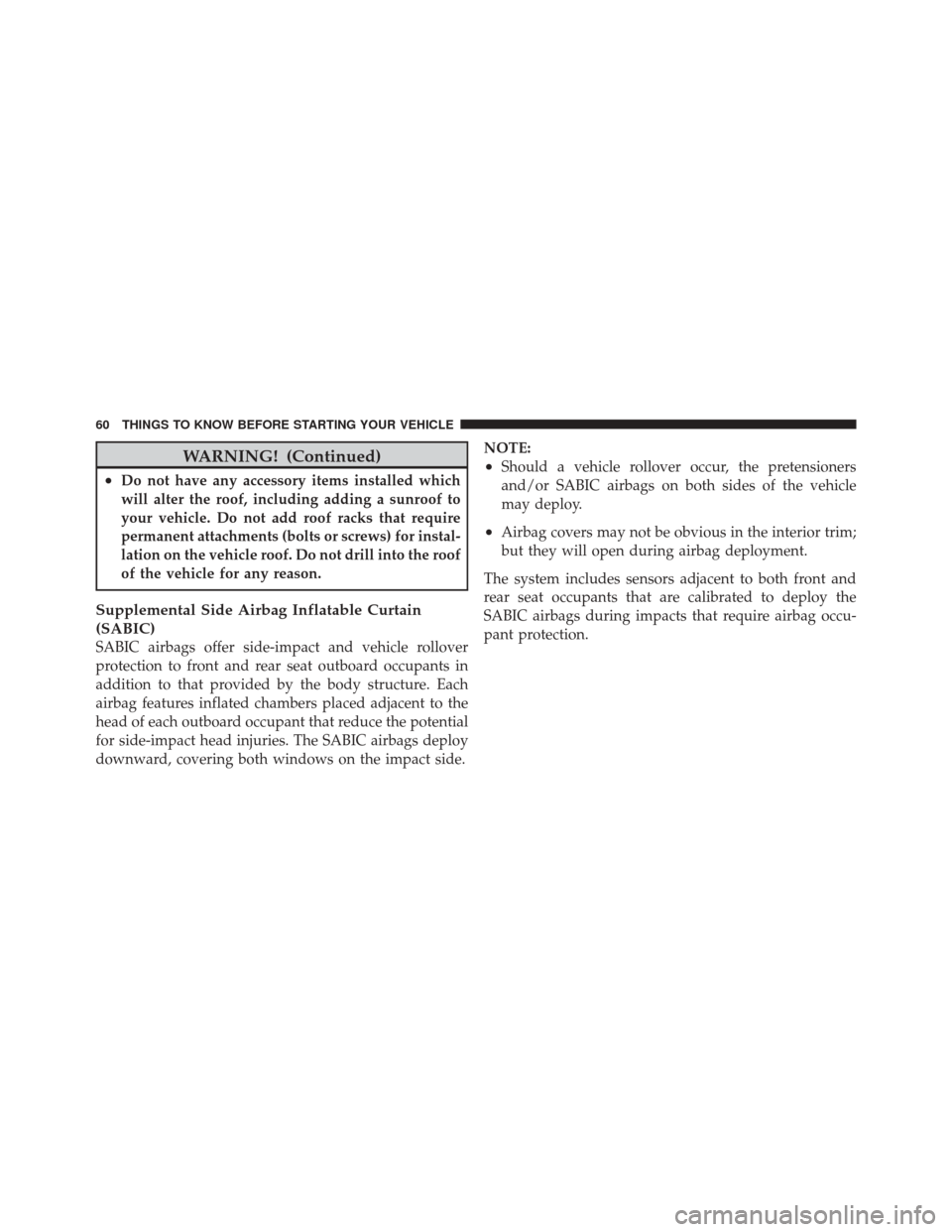
WARNING! (Continued)
•Do not have any accessory items installed which
will alter the roof, including adding a sunroof to
your vehicle. Do not add roof racks that require
permanent attachments (bolts or screws) for instal-
lation on the vehicle roof. Do not drill into the roof
of the vehicle for any reason.
Supplemental Side Airbag Inflatable Curtain
(SABIC)
SABIC airbags offer side-impact and vehicle rollover
protection to front and rear seat outboard occupants in
addition to that provided by the body structure. Each
airbag features inflated chambers placed adjacent to the
head of each outboard occupant that reduce the potential
for side-impact head injuries. The SABIC airbags deploy
downward, covering both windows on the impact side.NOTE:
•Should a vehicle rollover occur, the pretensioners
and/or SABIC airbags on both sides of the vehicle
may deploy.
•Airbag covers may not be obvious in the interior trim;
but they will open during airbag deployment.
The system includes sensors adjacent to both front and
rear seat occupants that are calibrated to deploy the
SABIC airbags during impacts that require airbag occu-
pant protection.
60 THINGS TO KNOW BEFORE STARTING YOUR VEHICLE
Page 64 of 522
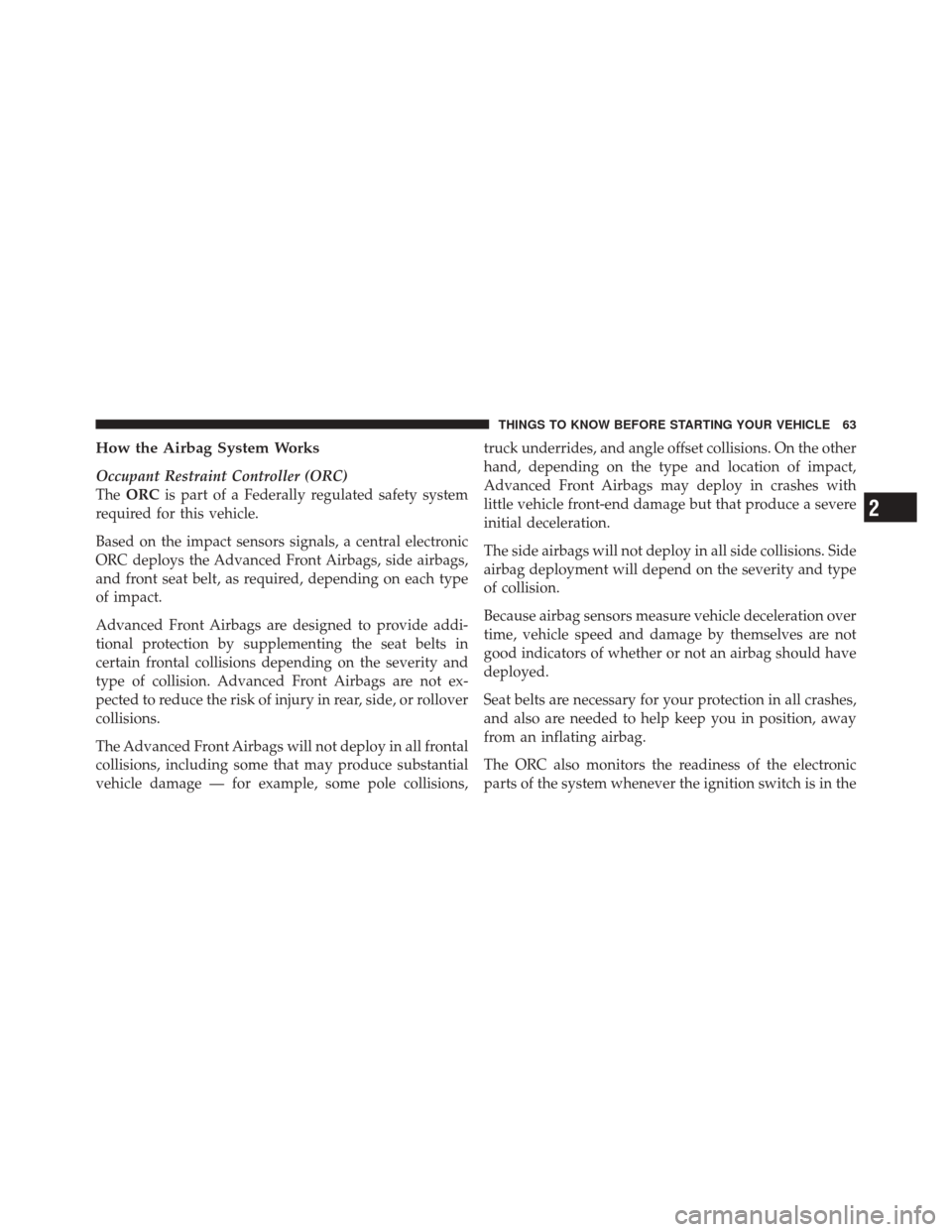
How the Airbag System Works
Occupant Restraint Controller (ORC)
TheORC is part of a Federally regulated safety system
required for this vehicle.
Based on the impact sensors signals, a central electronic
ORC deploys the Advanced Front Airbags, side airbags,
and front seat belt, as required, depending on each type
of impact.
Advanced Front Airbags are designed to provide addi-
tional protection by supplementing the seat belts in
certain frontal collisions depending on the severity and
type of collision. Advanced Front Airbags are not ex-
pected to reduce the risk of injury in rear, side, or rollover
collisions.
The Advanced Front Airbags will not deploy in all frontal
collisions, including some that may produce substantial
vehicle damage — for example, some pole collisions, truck underrides, and angle offset collisions. On the other
hand, depending on the type and location of impact,
Advanced Front Airbags may deploy in crashes with
little vehicle front-end damage but that produce a severe
initial deceleration.
The side airbags will not deploy in all side collisions. Side
airbag deployment will depend on the severity and type
of collision.
Because airbag sensors measure vehicle deceleration over
time, vehicle speed and damage by themselves are not
good indicators of whether or not an airbag should have
deployed.
Seat belts are necessary for your protection in all crashes,
and also are needed to help keep you in position, away
from an inflating airbag.
The ORC also monitors the readiness of the electronic
parts of the system whenever the ignition switch is in the
2
THINGS TO KNOW BEFORE STARTING YOUR VEHICLE 63
Page 67 of 522
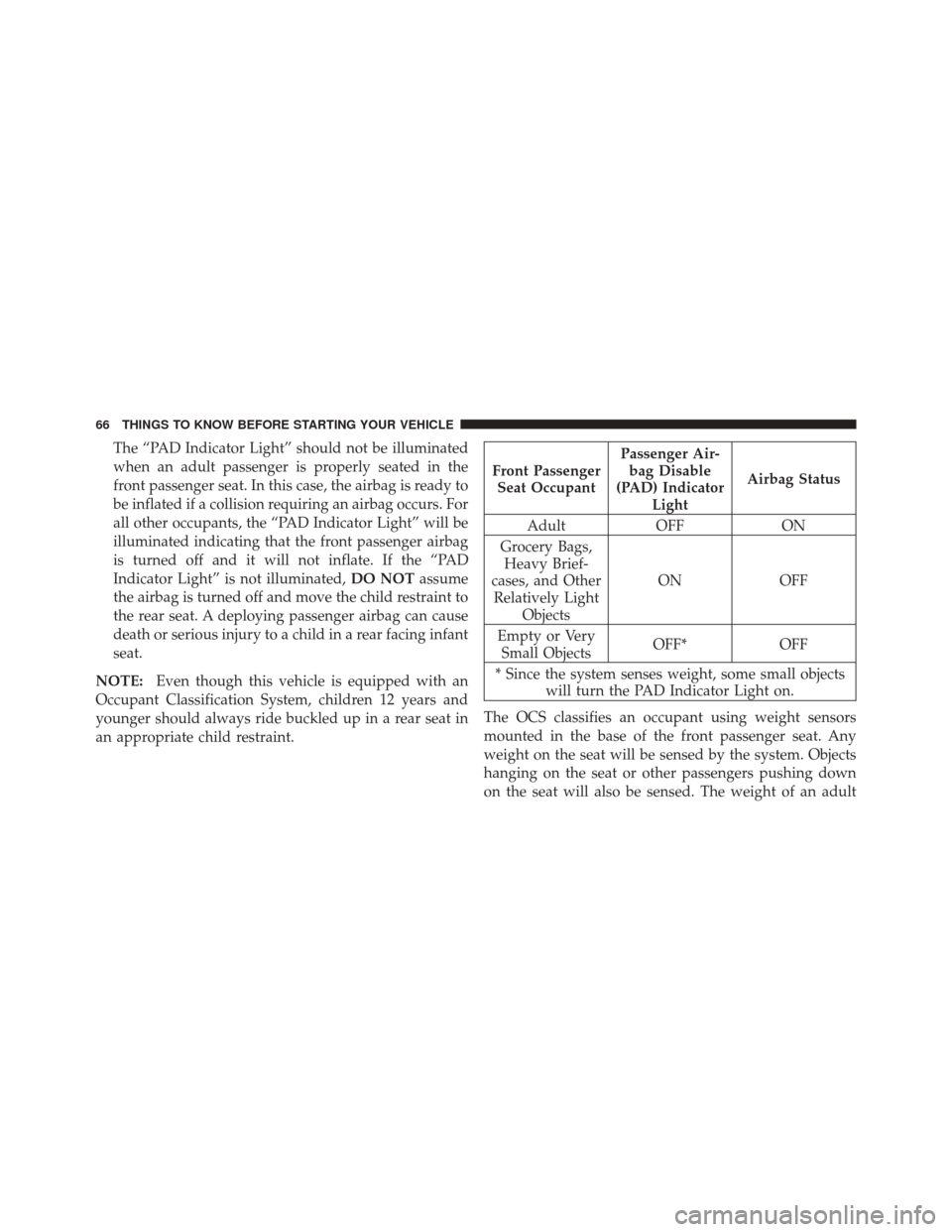
The “PAD Indicator Light” should not be illuminated
when an adult passenger is properly seated in the
front passenger seat. In this case, the airbag is ready to
be inflated if a collision requiring an airbag occurs. For
all other occupants, the “PAD Indicator Light” will be
illuminated indicating that the front passenger airbag
is turned off and it will not inflate. If the “PAD
Indicator Light” is not illuminated,DO NOTassume
the airbag is turned off and move the child restraint to
the rear seat. A deploying passenger airbag can cause
death or serious injury to a child in a rear facing infant
seat.
NOTE: Even though this vehicle is equipped with an
Occupant Classification System, children 12 years and
younger should always ride buckled up in a rear seat in
an appropriate child restraint.
Front Passenger Seat Occupant Passenger Air-
bag Disable
(PAD) Indicator Light Airbag Status
Adult OFFON
Grocery Bags, Heavy Brief-
cases, and Other Relatively Light Objects ON
OFF
Empty or Very Small Objects OFF*
OFF
* Since the system senses weight, some small objects will turn the PAD Indicator Light on.
The OCS classifies an occupant using weight sensors
mounted in the base of the front passenger seat. Any
weight on the seat will be sensed by the system. Objects
hanging on the seat or other passengers pushing down
on the seat will also be sensed. The weight of an adult
66 THINGS TO KNOW BEFORE STARTING YOUR VEHICLE
Page 68 of 522

will cause the system to turn the airbag on. In this case,
the OCS has classified the occupant of the seat as an
adult. An adult occupant needs to sit in a normal position
(with their feet on or near the floor) in order to be
properly classified. Reclining the seat back too far may
change how an occupant is classified by the OCS.
Drivers and adult passengers should verify that the
“PAD Indicator Light” is not illuminated when an adult
is riding in the front passenger seat. If an adult occu-
pant’s weight is transferred to another part of the vehicle
(like the door or instrument panel), the weight sensors in
the seat may not properly classify the occupant. Objects
lodged under the seat or between the seat and the center
console can prevent the occupant’s weight from being
measured properly and may result in the occupant being
improperly classified. Ensure that the front passenger
seatback does not touch anything placed on the back seatbecause this can also affect occupant classification. Also,
if you fold down the rear seat check to be sure it doesn’t
touch the front passenger seat.
If the front passenger seat is damaged in any way, it
should only be serviced by an authorized dealer. If the
seat is removed (or even if the seat attachment bolts are
loosened or tightened in any way), take the vehicle to an
authorized dealer.
If there is a fault present in the OCS, the “Airbag Warning
Light” (a red light located in the center of the instrument
cluster directly in front of the driver) will be turned on.
This indicates that you should take the vehicle to an
authorized dealer. The “Airbag Warning Light” is turned
on whenever there is a fault that can affect the operation
of the airbag system. If there is a fault present in the OCS,
both the “PAD Indicator Light” and the “Airbag Warning
Light” are illuminated to show that the passenger airbag
is turned off until the fault is cleared. If an object is
2
THINGS TO KNOW BEFORE STARTING YOUR VEHICLE 67
Page 69 of 522

lodged under the seat and interferes with operation of
the weight sensors, a fault will occur which turns on both
the “PAD Indicator Light” and the “Airbag Warning
Light.” Once the lodged object is removed, the fault will
be automatically cleared after a short period of time.
•TheDriver and Passenger Airbag/Inflator Units are
located in the center of the steering wheel and the right
side of the instrument panel. When the ORC detects a
collision requiring the airbags, it signals the inflator
units. A large quantity of non-toxic gas is generated to
inflate the Advanced Front Airbags. Different airbag
inflation rates are possible based on collision severity
and type. The steering wheel hub trim cover and the
upper right side of the instrument panel separate and
fold out of the way as the bags inflate to their full size.
The bags fully inflate in about 50 to 70 milliseconds.
This is about half of the time it takes to blink your eyes.
The bags then quickly deflate while helping to restrain
the driver and front passenger. The driver front airbag gas is vented through the vent
holes in the sides of the airbag. The passenger front
airbag gas is vented through the vent holes in the sides
of the airbag. In this way, the airbags do not interfere
with your control of the vehicle.
Along with seat belts and pretensioners, Advanced Front
Airbags work with the knee bolsters to provide improved
protection for the driver and front passenger. Side airbags
also work with seat belts to improve occupant protection.
•The Occupant Classification Module (OCM) is lo-
cated beneath the front passenger seat. The OCM
classifies the occupant into categories based on the
measurements made by the seat weight sensors. The
OCM communicates with the Occupant Restraint Con-
troller (ORC). The ORC uses the occupant category to
determine whether the front passenger airbag should
be turned off. It also determines the rate of airbag
inflation during a collision.
68 THINGS TO KNOW BEFORE STARTING YOUR VEHICLE
Page 70 of 522
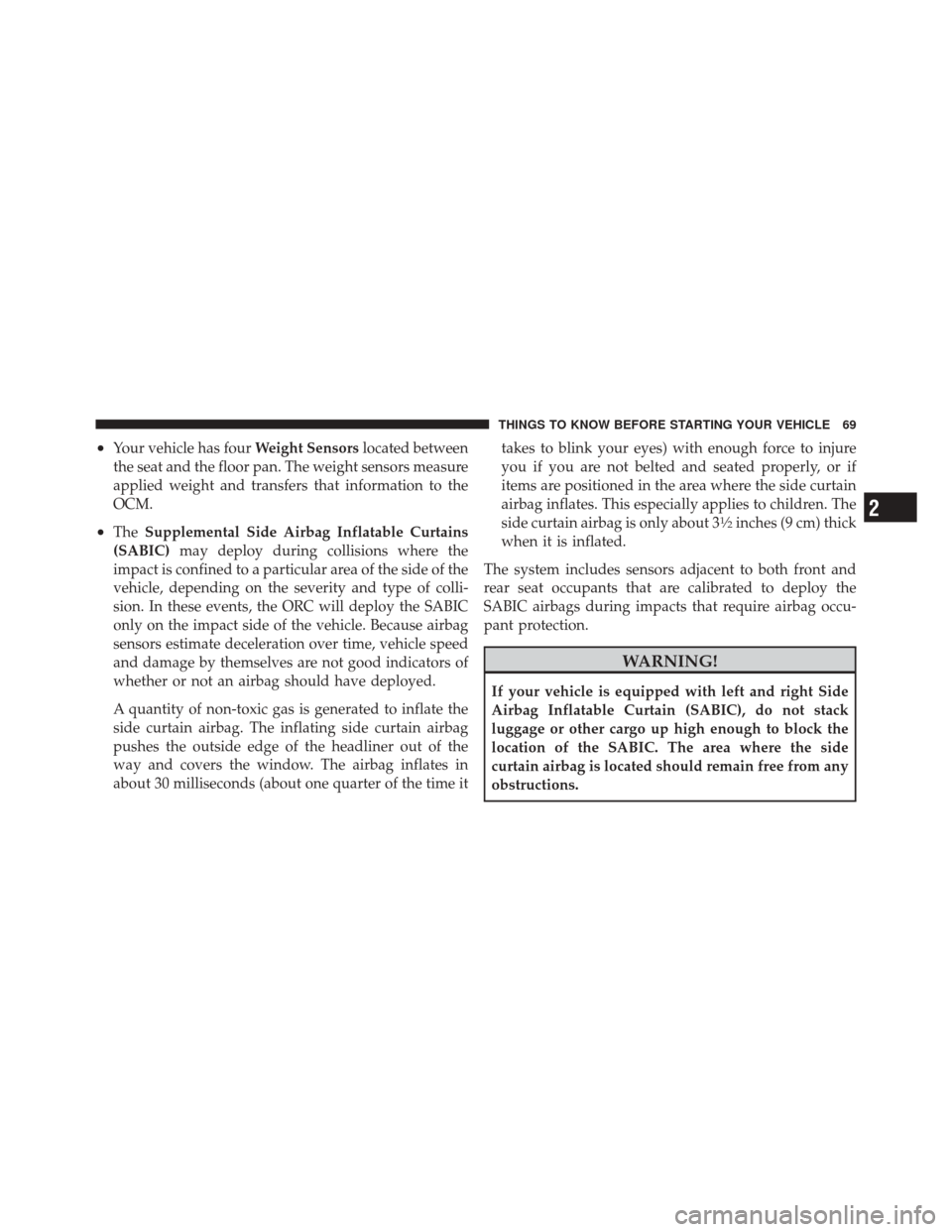
•Your vehicle has fourWeight Sensorslocated between
the seat and the floor pan. The weight sensors measure
applied weight and transfers that information to the
OCM.
•The Supplemental Side Airbag Inflatable Curtains
(SABIC) may deploy during collisions where the
impact is confined to a particular area of the side of the
vehicle, depending on the severity and type of colli-
sion. In these events, the ORC will deploy the SABIC
only on the impact side of the vehicle. Because airbag
sensors estimate deceleration over time, vehicle speed
and damage by themselves are not good indicators of
whether or not an airbag should have deployed.
A quantity of non-toxic gas is generated to inflate the
side curtain airbag. The inflating side curtain airbag
pushes the outside edge of the headliner out of the
way and covers the window. The airbag inflates in
about 30 milliseconds (about one quarter of the time it takes to blink your eyes) with enough force to injure
you if you are not belted and seated properly, or if
items are positioned in the area where the side curtain
airbag inflates. This especially applies to children. The
side curtain airbag is only about 31�2inches (9 cm) thick
when it is inflated.
The system includes sensors adjacent to both front and
rear seat occupants that are calibrated to deploy the
SABIC airbags during impacts that require airbag occu-
pant protection.
WARNING!
If your vehicle is equipped with left and right Side
Airbag Inflatable Curtain (SABIC), do not stack
luggage or other cargo up high enough to block the
location of the SABIC. The area where the side
curtain airbag is located should remain free from any
obstructions.
2
THINGS TO KNOW BEFORE STARTING YOUR VEHICLE 69
Page 75 of 522

NOTE:
1. A near-deployment event occurs when the airbag
sensor detects severe vehicle deceleration usually indica-
tive of a crash, but not severe enough to warrant airbag
deployment.
2. Under certain circumstances, EDR data may not be
recorded (e.g., loss of battery power).
In conjunction with other data gathered during a com-
plete accident investigation, the electronic data may be
used by Chrysler Group LLC and others to learn more
about the possible causes of crashes and associated
injuries in order to assess and improve vehicle perfor-
mance. In addition to crash investigations initiated by
Chrysler Group LLC, such investigations may be re-
quested by customers, insurance carriers, government
officials, and professional crash researchers, such as those
associated with universities, and with hospital and insur-
ance organizations.In the event that an investigation is undertaken by
Chrysler Group LLC (regardless of initiative), the com-
pany or its designated representative will first obtain
permission of the appropriate custodial entity for the
vehicle (usually the vehicle owner or lessee) before
accessing the electronic data stored, unless ordered to
download data by a court with legal jurisdiction (i.e.,
pursuant to a warrant). A copy of the data will be
provided to the custodial entity upon request. General
data that does not identify particular vehicles or crashes
may be released for incorporation in aggregate crash
databases, such as those maintained by the U.S. govern-
ment and various states. Data of a potentially sensitive
nature, such as would identify a particular driver, ve-
hicle, or crash, will be treated confidentially. Confidential
data will not be disclosed by Chrysler Group LLC to any
third party except when:
74 THINGS TO KNOW BEFORE STARTING YOUR VEHICLE